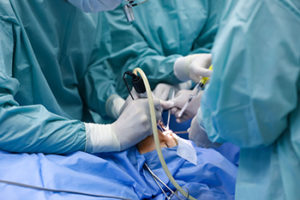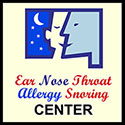Sinus Procedures
 We offer a full range of Otolaryngology and ENT services
We offer a full range of Otolaryngology and ENT services
Balloon Sinuplasty
Balloon sinus dilation is a newer, minimally-invasive option to treat sinus problems. Rather than removing tissue to open an obstructed sinus, this technique involves passing a lighted guidewire into a sinus followed by a balloon that dilates the sinus outflow allowing for improved drainage, ventilation, and even therapeutic rinsing of the sinuses. When patients are appropriately selected, it has been shown to improve sinusitis symptoms as effectively as traditional sinus surgery. Balloon sinuplasty may be performed under local anesthesia (awake with numbing medicine), light oral sedation (pills that decrease anxiety and may cause drowsiness), or general anesthesia/IV sedation. This office procedure can be combined with limited surgical procedures (such as ethmoidectomy, removal of the collection of small sinuses that cannot be balloon dilated) in order to maximize long-term results while limiting post-operative discomfort, bleeding risk, and expense compared to traditional sinus surgery.
Learn More About Balloon Sinuplasty
Sinus Surgery
Medical therapy often fails to resolve or control sinus problems, particularly in the setting of symptoms lasting for more than 3 months, frequently recurring sinus infections, nasal polyps, and other abnormalities of the sinuses such as mucoceles (expansion of an obstructed sinus). In these individuals, endoscopic sinus surgery provides lasting improvement of symptoms such as nasal congestion, pressure or pain in the sinuses, purulent nasal drainage, and is likely to improve sense of smell, quality of sleep, energy levels, and more. Advances in technology and endoscopic surgical techniques have significantly improved patient experiences, safety, and outcomes for sinus surgery over the last ten to twenty years. In nearly every case, the sinuses can be opened, cleared of disease, and healthy outcomes maintained without any visible incisions or changes in your appearance. A Fellowship-trained sinus surgeon is best-suited to deliver state-of-the-art surgical care with the best possible outcomes and maintain the health of your sinuses following surgery through a personalized treatment approach that accounts for all of the causes of your sinus-related symptoms.
Septoplasty
Surgical correction of a deviated septum, or septoplasty, may be required to improve nasal breathing in patients with significant septal deformities. This is particularly true if nasal obstruction always seems worse on the same side, rather than moving back and forth between the nasal passages. Nasal obstruction may contribute to snoring, sleep apnea, and exercise intolerance. Fortunately, septoplasty performed endoscopically (through the nostrils without visible incisions) can alleviate nasal obstruction and restore symmetry to nasal airflow with minimal risk and fast recovery. Splints and nasal packing are rarely required when utilizing endoscopic techniques, and most patients wake up from the procedure breathing better than ever.
Consult with our Fellowship-trained Rhinology expert to evaluate the causes of your nasal obstruction symptoms and effectively relieve them.
Turbinoplasty
Alternating nasal obstruction caused by enlarged turbinates can be effectively treated with multiple procedures. The most effective long-term solution, submucous resection (SMR) turbinoplasty, involves conservative removal of tissue and bone from the bottom of each turbinate under general anesthesia. This both decreases their size and allows them to sit further from the septum, effectively enlarging the nasal passages. Other methods of turbinoplasty include radiofrequency ablation (RFA) and coblation, both of which contract the soft tissues of the turbinate using a needle-like probe and can be done under local anesthesia in the office setting. These conservative approaches ensure that nasal breathing improves while preserving the natural function of the turbinates, which warm and humidify air and sense air movement within the nasal passages. Trials of nasal steroid sprays (such as Flonase) are required for one to two months prior to consideration of turbinoplasty procedures.
Treatments for Rhinitis (Allergies or other causes of nasal drip and congestion)
Allergic rhinitis, vasomotor rhinitis, and medically-induced rhinitis (decongestant abuse) are similar, yet different conditions leading to nasal drainage and irritation with very specific causes that require specific (but different) treatments. For instance, inhalant allergies (pollen, dust mites, pet dander, etc.) can often be treated effectively with antihistamine pills, nasal steroid/antihistamine sprays, and allergy testing with immunotherapy in the form of shots or sublingual drops, whereas vasomotor rhinitis is treated with a different anticholinergic nasal spray. Rhinitis caused by decongestant (ex. Afrin) abuse often responds to tapering of decongestant sprays (often using saline dilution of the spray) and topical nasal steroid sprays to reduce inflammation and swelling. Office Sinus CT’s are obtained in many such patients to ensure that other pathologies such as chronic sinusitis are not also present before deciding on the appropriate treatment strategy. Newer technologies such as cryotherapy to the posterior nasal nerves (Clarifix device) are also proving effective when other medications fail to relieve symptoms.
Nasal Valve Procedures
The nasal valve refers to the narrow area just inside of the nostril where the “pinched” portion above the nostril contacts the septum while breathing in deeply. In a normal nose, this narrow space remains open due to structural support provided by the upper lateral cartilage. However, in some individuals this valve area is collapsed or compromised by deviation of the nasal septum, inward displacement of the upper lateral cartilage, or thinning of this cartilage with loss of structural support leading to collapse of the valve with gentle nasal breathing. Various procedures have been developed to address these potential nasal valve conditions, many involving septo-rhinoplasty with cartilage grafting to widen or reinforce the nasal valve. Newer less-invasive techniques can, in certain patients, provide comparable results using radiofrequency ablation (RFA) or dissolvable implants to widen the nasal valve or provide increased structural support, respectively.
Repair of CSF Leaks in the Nose and Sinuses
Cerebrospinal fluid (CSF) is a clear, salty fluid that surrounds and protects the central nervous system (brain and spinal cord). In most cases, CSF leaks within the nose or sinus cavities can be repaired endoscopically through the nostrils using sinus surgery techniques and instrumentation readily available in most hospitals. Patches often utilized include nasal mucosa and other biologic materials, in addition to rotation of vascularized tissue from the nasal septum to cover larger defects. While larger, higher-flow leaks are certainly more urgent with higher risk of complication, even small intermittent leaks can pose infection risks and should be addressed without delay.
Repair of Obstructed Tear Ducts
a. Dacryocystorhinostomy (DCR) is a procedure that involves endoscopic sinus surgery instrumentation and techniques to open the lacrimal system widely into the nasal cavity without any external incisions. This new opening between the lacrimal sac and nasal cavity bypasses an obstructed or dysfunctional nasolacrimal duct, which is a common cause of excessive tearing (epiphora). Stents are rarely needed, and are often avoided as they may induce inflammation and scarring within the lacrimal system.
Orbital Decompression Surgery
Approximately 30% of patients with Graves Disease (autoimmune thyroid condition) will develop a secondary condition known as Graves Ophthalmopathy. In these patients, progressive enlargement of the muscles that move the eye and surrounding orbital fat leads to eye bulging, or exophthalmos. Exophthalmos may cause eye irritation, dryness, corneal problems, and in rare cases even double vision. Orbital proptosis can be alleviated with an endoscopic procedure known as orbital decompression surgery, which uses endoscopic sinus surgery techniques to remove the thin bone encasing the orbit along one or more sides (generally, the side adjacent to the ethmoid sinuses and a portion of the lower orbital wall that forms the roof of the maxillary sinus). This removal of bone allows the contents of the eye socket to bulge inward, rather than outward, and the eye moves inward toward the orbit between 2 to 12mm following this procedure. Correction of exophthalmos allows for improved eye closure, reducing the dryness, irritation, and other exposure-related eye problems resulting from Graves Ophthalmopathy.
Endoscopic Skull Base or Pituitary Surgery
Pituitary tumors and other pathology involving the skull base (meningiomas, olfactory neuroblastomas, and many uncommon pathologies) can be surgically approached using less invasive endoscopic techniques, often with better results and shorter hospital stays compared to open or microscopic approaches. Neurosurgeons and Fellowship-trained Rhinologists collaborate to ensure that the selected surgical approach is performed safely and effectively. In addition, the Rhinologist helps ensure that post-procedure sinus problems, nasal obstruction symptoms, spinal fluid leaks, and other potential complications are avoided (or quickly corrected using endoscopic techniques when needed).
Consult with our Fellowship-trained Rhinology expert if you have a pituitary or skull base condition that might benefit from a collaborative, endoscopic surgical approach between a Rhinologist and a Neurosurgeon.
